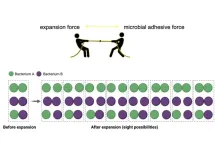(Press-News.org) (Santa Barbara, Calif.) — Shifting our diets to be more sustainable can be a powerful way for each of us to address both climate change and global food insecurity, however making such adjustments at the large scales necessary to make a difference globally can be a delicate matter.
“Changes in food demand in one part of the world can have cascading environmental and human welfare implications for people around the world),” said Joe DeCesaro, data analyst at UC Santa Barbara’s National Center for Ecological Analysis & Synthesis (NCEAS).
Despite the seemingly daunting complexity of the global food system, to ensure a healthy population and planet, global diet shifts are required. To remove some of the uncertainty surrounding such an ambitious yet necessary endeavor, DeCesaro and an international collaboration of researchers set out to understand where and how these environmental pressures might occur within hypothetical global shifts to each of four types of diets: Indian, Mediterranean, EAT-Lancet (largely plant-based, “flexitarian”) and average government-recommended food-based dietary guidelines (FBDGs). The most beneficial of the four? The Indian diet, with an estimated 20.9% reduction in food production-based global environmental pressure. The least beneficial of the selected diets? FBDGs, with a potential 35.2% global increase in environmental pressure.
The researchers’ study is published in the journal Environmental Research Letters.
Following food flow
The global food system is one of the largest drivers of environmental change, according to the study, contributing to about a third of global greenhouse gas emissions and using more than 70% of freshwater resources, on top of degrading and disturbing land for agriculture and contributing the majority of nutrient pollution in waterways and coastal waters. For these reasons, moving toward a more sustainable diet — one that leans away from resource-intensive foods like red meat, for instance — can ease the pressure on the environment, with the added benefit of being healthier, especially when the diet also involves cutting back on refined sugars and starches and increasing nutrient-dense foods such like vegetables and legumes.
But that’s just part of the solution, according to the researchers.
“We wanted to know who would actually be feeling the change from the food production if these shifts occur,” said Ben Halpern, NCEAS director and a coauthor on the study. What has not been well understood is how environmental pressures may move, or if new ones might be generated by a large-scale shift in diet, especially given that food is often produced in one part of the world and eaten in another part of the world.
“The research was motivated originally by the question: Who’s consumption is generating the pressures of food production that are being felt by people and places around the world?” DeCesaro said. “Are poorer countries paying the environmental price of producing higher pressure foods that are being eaten by richer countries or vice versa? Our methods allow us to track changes in the environmental pressures from the producer to the consumer, and vice versa, in a standardized format across four pressures. Our work is quite novel in this space.”
Using available data on a variety of factors, including countries’ average diets, trade flow and the global environmental pressures of food production, the researchers were able to map to a high degree of precision the changes in environmental pressure that would occur with a global shift to each of four types of diets, the mostly vegetarian Indian diet, the plant-forward Mediterranean and EAT-Lancet diets, and average government-recommended dietary guidelines.
“We felt these four diet scenarios gave us a good variation of diet types from low meat to higher quantities of meat and dairy while also maintaining cultural relevance,” noted DeCesaro. “The Indian and FBDGs being directly from government recommendations, the Mediterranean being widely discussed for its health benefits, and the EAT-Lancet diet being developed by subject matter experts.”
The researchers found that shifts to three of the four diets examined — all except the FBDGs — resulted in reductions in global cumulative pressure. The Indian diet in particular performed the best out of the sustainable popular diets largely due to the difference in red meat consumption — the Indian diet recommends no red meat while the FBDGs typically recommend more red meat than countries already consume.
Meanwhile, global reductions in pressure, according to the study, would come mostly from dietary shifts in higher-income countries.
“Higher-income countries’ average current diets have higher consumption quantities of most food categories than the recommended quantities in our diet scenarios,” DeCesaro said. “Essentially, these countries are over-consuming, compared to the recommendations of the diet scenarios, while lower-income countries are, on average, under-consuming in these categories.”
Additionally, should the world shift toward more sustainable, plant-forward diets, lower-income countries would see an increase to their food-production related environmental pressures, DeCesaro said, “but that is mainly due to the diet scenarios meeting more of their daily needs.” To ensure the goals of food security and equitable access to adequate nutrition for these countries, the authors call for support from wealthier countries via access to imports of efficiently produced foods, economic development where it can improve dietary health and reduce environmental pressures of food production, and through innovation and knowledge sharing of efficient and environmental food production practices.
“Sharing sustainable agricultural practices will help reduce any increases in pressures seen from diet shifts,” DeCesaro said. Continuing in this vein, the researchers are currently working to directly analyze current food trade patterns and the subsequent environmental pressures traded with it, with no diet shifts.
“A big message from our work,” summarized Halpern, “is that the decisions we make about what we eat are important for reducing our environmental footprint, but other people may pay the price for those decisions.”
END
Revealing the hidden costs of what we eat
Researchers find that shifting diets will ease cumulative environmental pressures for many but increase them for others
2024-11-18
ELSE PRESS RELEASES FROM THIS DATE:
New therapies at Kennedy Krieger offer effective treatment for managing Tourette syndrome
2024-11-18
BALTIMORE, November 18, 2024— Researchers at Kennedy Krieger Institute have made significant strides in improving the lives of patients with Tourette syndrome. Their recent publication highlights how behavioral therapies—an approach that teaches patients how to manage certain tics using behavioral strategies—are proving to be the most effective treatment.
Tourette syndrome (TS), a neurodevelopmental disorder affecting up to 1% of the population, is characterized by motor and vocal tics, which are sudden, repetitive movements or sounds that can significantly ...
American soil losing more nutrients for crops due to heavier rainstorms, study shows
2024-11-18
UNIVERSITY PARK, Pa. — Phosphorus, a nutrient in soil essential for sustaining most forms of life, is increasingly disappearing from land as it is washed into waterways throughout the United States, according to a new study led by researchers at Penn State.
The study, published today (Nov. 18) in the Proceedings of the National Academy of Sciences, analyzed data from 430 rivers across the U.S. and found that phosphorus loss from agricultural lands has increased over the past four decades, despite efforts to reduce it. This loss of phosphorus ...
With new imaging approach, ADA Forsyth scientists closely analyze microbial adhesive interactions
2024-11-18
Cambridge, Mass., 11/18/2024 – Scientists have identified many types of bacteria in the mouth, but many problems remain in understanding how they work with one another. One of the problems is that microbes assemble themselves into densely packed multi-species biofilms. Their density and complexity pose acute difficulties for visualizing individual cells and analyzing their interactions at single-cell level.
ADA Forsyth scientists have developed a new imaging approach that makes it possible to analyze the spatial connections between bacteria, including the strength of adhesive forces that hold them together. Adhesion is of fundamental importance in ...
Global antibiotic consumption has increased by more than 21 percent since 2016
2024-11-18
Washington, DC / Bangalore, India — A new study highlights recent, but fluctuating, growth in global human antibiotic consumption, one of the main drivers of growing antimicrobial resistance (AMR). AMR results in infections that no longer respond to antibiotics (and other antimicrobial medicines) and often leads to longer hospital stays, higher treatment costs, and higher mortality rates. AMR is estimated to be associated with nearly five million global deaths annually.
Researchers affiliated with the One Health Trust (OHT), the Population Council, GlaxoSmithKline, the University of Zurich, the University of Brussels, ...
New study shows how social bonds help tool-using monkeys learn new skills
2024-11-18
The research team, led by Durham University’s Department of Anthropology, studied two groups of wild bearded capuchin monkeys in Brazil’s Serra da Capivara National Park.
The researchers installed a large box in the park which contained food that the monkeys could access by either lifting a door or pulling a knob.
The team observed which monkeys learned how to access the food, and how that information then spread to the rest of their group.
The researchers specifically focused on the role played by social tolerance in the learning of the problem-solving behaviour.
Social tolerance determines who is allowed ...
Modeling and analysis reveals technological, environmental challenges to increasing water recovery from desalination
2024-11-18
Climate change is making water scarcer. A promising method to combat this problem is desalination technology because it can tap seawater. Though desalination has potential, it also brings risks with environmental impact, cost, and accessibility. Zero liquid discharge (ZLD) technology aims to increase water recovery from desalination by squeezing more water out of desalination brine. ZLD can help reduce water scarcity and waste from desalination plants, but comes at increased costs and, potentially, increased environmental effects from desalination.
In ...
Navy’s Airborne Scientific Development Squadron welcomes new commander
2024-11-18
WASHINGTON — Cmdr. J. Aaron Roberts relinquished command of the U.S. Naval Research Laboratory’s (NRL) Scientific Development Squadron (VXS) 1, the Warlocks, to Cmdr. Luis A. Levine, the new Commanding Officer (CO), during a change of command and retirement ceremony Nov. 14 at Naval Air Station (NAS) Patuxent River, Maryland.
NRL’s CO Capt. Jesse Black presented Roberts with the Meritorious Service Medal. Roberts served as the VXS-1 CO from May 2023 to November 2024 and the U.S. Navy for 21 years. Black said Roberts’ distinguished leadership was instrumental to the squadron’s continued record of exceptional support to NRL’s airborne ...
TāStation®'s analytical power used to resolve a central question about sweet taste perception
2024-11-18
PHILADELPHIA, PA – November 18, 2024 – Opertech Bio, Inc., a leading innovator in taste assessment, today announced the publication of a research article in which the TāStation® rapid throughput taste evaluation system was used to resolve a central question about sweet taste perception.
It has been well established that sweeteners impart their taste by activating the TAS1R2/TAS1R3 “sweet taste receptor” in the tongue. A second signaling pathway involving the activity of glucose transporters, operating independently of the receptor, recently has been proposed for metabolizable caloric sweeteners. In a powerful demonstration of the analytical ...
NASA awards SwRI $60 million contract to develop next-generation coronagraphs
2024-11-18
Southwest Research Institute has won a $60 million contract to build three coronagraphs for the National Oceanic and Atmospheric Administration (NOAA). SwRI’s novel Space Weather Solar Coronagraph (SwSCOR) is NOAA’s next-generation instrument to provide early detection and characterization of Earth-directed coronal mass ejections (CMEs).
CMEs are huge bursts of coronal plasma threaded with intense magnetic fields ejected from the Sun over the course of several hours. CMEs arriving at Earth can generate geomagnetic storms, which can cause anomalies in and disruptions ...
Reducing antimicrobial resistance: accelerated efforts are needed to meet the EU targets
2024-11-18
Between 2019 and 2023, antibiotic consumption in the EU increased by 1%, moving further away from the 2030 target of a 20% reduction recommended by the Council of the European Union.
Although there have been significant reductions in methicillin-resistant Staphylococcus aureus bloodstream infections during the same period, the situation in other critical areas, such as carbapenem-resistant Klebsiella pneumoniae bloodstream infections, has worsened, with an increase in incidence by almost 60% between 2019 and 2023. This represents a growing threat to patients in hospitals across the EU, particularly since very few therapeutic options remain available to treat patients infected with ...
LAST 30 PRESS RELEASES:
Tracing the quick synthesis of an industrially important catalyst
New software sheds light on cancer’s hidden genetic networks
UT Health San Antonio awarded $3 million in CPRIT grants to bolster cancer research and prevention efforts in South Texas
Third symposium spotlights global challenge of new contaminants in China’s fight against pollution
From straw to soil harmony: International team reveals how biochar supercharges carbon-smart farming
Myeloma: How AI is redrawing the map of cancer care
Manhattan E. Charurat, Ph.D., MHS invested as the Homer and Martha Gudelsky Distinguished Professor in Medicine at the University of Maryland School of Medicine
Insilico Medicine’s Pharma.AI Q4 Winter Launch Recap: Revolutionizing drug discovery with cutting-edge AI innovations, accelerating the path to pharmaceutical superintelligence
Nanoplastics have diet-dependent impacts on digestive system health
Brain neuron death occurs throughout life and increases with age, a natural human protein drug may halt neuron death in Alzheimer’s disease
SPIE and CLP announce the recipients of the 2025 Advanced Photonics Young Innovator Award
Lessons from the Caldor Fire’s Christmas Valley ‘Miracle’
Ant societies rose by trading individual protection for collective power
Research reveals how ancient viral DNA shapes early embryonic development
A molecular gatekeeper that controls protein synthesis
New ‘cloaking device’ concept to shield sensitive tech from magnetic fields
Researchers show impact of mountain building and climate change on alpine biodiversity
Study models the transition from Neanderthals to modern humans in Europe
University of Phoenix College of Doctoral Studies releases white paper on AI-driven skilling to reduce burnout and restore worker autonomy
AIs fail at the game of visual “telephone”
The levers for a sustainable food system
Potential changes in US homelessness by ending federal support for housing first programs
Vulnerability of large language models to prompt injection when providing medical advice
Researchers develop new system for high-energy-density, long-life, multi-electron transfer bromine-based flow batteries
Ending federal support for housing first programs could increase U.S. homelessness by 5% in one year, new JAMA study finds
New research uncovers molecular ‘safety switch’ shielding cancers from immune attack
Bacteria resisting viral infection can still sink carbon to ocean floor
Younger biological age may increase depression risk in older women during COVID-19
Bharat Innovates 2026 National Basecamp Showcases India’s Most Promising Deep-Tech Ventures
Here’s what determines whether your income level rises or falls
[Press-News.org] Revealing the hidden costs of what we eatResearchers find that shifting diets will ease cumulative environmental pressures for many but increase them for others






